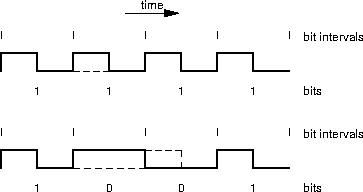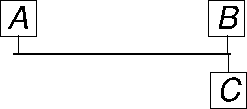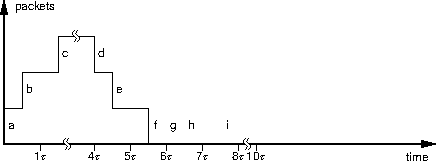Given the possibly noisy signal
comment on its fidelity to biphase-mark encoding, and describe, as best as possible, the bit string encoded.
The obvious problem with the noisy signal is the missing transition at the start of the second bit interval. Assuming the missing transition is the first error to occur, adding a transition to the start of the second bit interval fixes the problem at one end of the interval, but causes a problem at the other:
But now there's no transition at the start of the third bit interval. Adding a transition at the middle of the second or the start of the third bit interval fixes that problem.
Alternatively, the first error could have been the transition in the middle of the first bit interval. Removing that transition produces a valid signal with only one change.
All these answers are acceptable, but Occam’s razor favors the last answer.
Each host i has a packet for transmission at time ti : tA = 0, tB = τ/2 and tC = 3τ/2. Each packet takes 4τ time to transmit. Assuming that time increases horizontally to the right, diagram what happens to all three packets when all the hosts use
to transmit packets.
- ALOHA
- Nonpersistent CSMA
- CSMA/CD
- Host A begins transmitting its packet.
- Host B begins transmitting its packet, trashing it and A’s packet.
- Host C begins transmitting its packet, trashing it.
- Host A finishes transmitting its packet and waits for an acknowledgment, setting a time-out of length 2τ to end the wait.
- Host B finishes transmitting its packet and waits for an acknowledgment, setting a time-out of length 2τ to end the wait.
- Host C finishes transmitting its packet and waits for an acknowledgment, setting a time-out of length 2τ to end the wait.
- Host A’s acknowledgment time-out expires. A generates a random backoff of 1, and schedules a retransmission 1·4τ from now.
- Host B’s acknowledgment time-out expires. B generates a random backoff of 2, and schedules a retransmission 2·4τ from now.
- Host C’s acknowledgment time-out expires. C generates a random backoff of 3, and schedules a retransmission 3·4τ from now.
three
four
five






